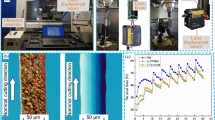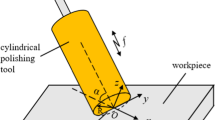Abstract
With the development of science and technology, many precision fields have higher requirements for the machining quality and precision of hard and brittle materials. Brittle materials such as glass and ceramics have fragile physical properties, resulting in poor stability during machining. Ultrasonic vibration-assisted polishing (UVAP) is suitable for machining various brittle materials and can well solve the machining problems caused by the characteristics of brittle materials. In order to ensure the machining quality, a polishing force model of K9 optical glass for different processing parameters is established in this paper. The new model mainly considers the following aspects: (1) Considering the randomness of shape, the truncated polyhedral model is used to model the abrasive particles. (2) Based on the fractal theory and mathematical statistics, a microscopic morphology model of the polishing tool is established. (3) Based on the N–S equation, a polishing force model considering the micro-contact states of the polishing tool, abrasive particles, and workpiece is established. By comparing with the experimental results, the new model has high accuracy in predicting the polishing force. The new model and results lay the foundation for the subsequent research of brittle materials.



















Similar content being viewed by others
Data availability
The datasets supporting the conclusion of this article are included within the article.
Abbreviations
- \(\text{a}_\text{t}\) :
-
Contact area between polishing tool and workpiece \((\text{mm}^2)\)
- \(\text{d}_\text{e}\) :
-
Number of Euclidean spatial dimensions
- \(\text{d}_\text{p}\) :
-
Diameter of abrasive particle (\(\mu \text{m}\))
- \(\text{d}_\text{m}\) :
-
Diameter of asperity (\(\mu \text{m}\))
- \(\text{D}_\text{f}\) :
-
Fractal dimension
- \(\text{E}_\text{m}\) :
-
Elastic modulus of polishing tool (Gpa)
- \(\text{E}_\text{mw}\) :
-
Equivalent elastic modulus of polishing tool and workpiece (Gpa)
- \(\text{E}_\text{p}\) :
-
Elastic modulus of abrasive particle (Gpa)
- \(\text{E}_\text{pw}\) :
-
Equivalent elastic modulus of abrasive particle and workpiece (Gpa)
- \(\text{E}_\text{w}\) :
-
Elastic modulus of workpiece (Gpa)
- \(\text{F}_{\text{a}-\text{l}}^{\text{t}-\text{i}}\) :
-
Maximum horizontal impact force (N)
- \(\text{F}_{\text{a}-\text{z}}^{\text{t}-\text{i}}\) :
-
Maximum normal impact force (N)
- \(\text{F}_\text{ep}\) :
-
Critical elastic-plastic contact force (N)
- \(\text{F}_{\text{f}-\text{l}}^{\text{t}-\text{i}}\) :
-
Scratching force in horizontal direction (N)
- \(\text{F}_{\text{f}-\text{z}}^{\text{t}-\text{i}}\) :
-
z-direction force generated by asperity (N)
- \(\text{F}_{\text{X}-\text{t}}\) :
-
Polishing force in x-direction (N)
- \(\text{F}_{\text{Y}-\text{t}}\) :
-
Polishing force in y-direction (N)
- \(\text{F}_{\text{Z}-\text{t}}\) :
-
Polishing force in z-direction (N)
- G:
-
Characteristic scale coefficient
- \(\text{h}_{\text{s}}\) :
-
Thickness of slurry film (\(\mu \text{m}\))
- \(\text{h}_{\text{t}}\) :
-
Distance between polishing tool and workpiece (\(\mu \text{m}\))
- \(\text{k}_{\text{p}}\) :
-
Preston coefficient
- \(\text{N}_{\text{a}}\) :
-
Total number of the free abrasive particles
- \(\text{N}_{\text{m}}\) :
-
Total number of asperities subjected to extrusion
- \(\text{P}_{\text{0}}\) :
-
Hydrostatic pressure of the slurry outside the bubble (pa)
- \(\text{P}_{\text{b}}\) :
-
Pressure at the bubble collapse point (pa)
- \(\text{P}_{\text{v}}\) :
-
Pressure inside the cavitation bubble (pa)
- \(\text{r}_{\text{p}}\) :
-
Radius of abrasive particle (\(\mu \text{m}\))
- \(\text{R}_{\text{q}}\) :
-
Radius of the cavitation bubble (\(\mu \text{m}\))
- \(\text{u}_{\text{r}2-\text{t}}^{\text{i}}\) :
-
Radial velocity of polishing slurry (m/s)
- \(\text{u}_{\theta 2-\text{t}}^{\text{i}}\) :
-
Circumferential velocity of polishing slurry (m/s)
- \(\text{v}_{\text{0}}\) :
-
Initial velocity of abrasive particle (m/s)
- \(\text{v}_{\text{t}}\) :
-
Feed rate of polishing tool (mm/s)
- \(\text{z}_{\text{m}}\) :
-
Height of asperity (\(\mu \text{m}\))
- \(\gamma_{\text{p}}\) :
-
Poisson’s ratio of abrasive particle
- \(\gamma_{\text{s}}\) :
-
Specific heat capacity ratio
- \(\gamma_{\text{w}}\) :
-
Poisson’s ratio of workpiece
- \({\mu}_{\text{r}-\text{t}}^{\text{i}}\) :
-
Sliding friction coefficient
- \({\rho}_{\text{f}}\) :
-
Density of polishing slurry (\(\text{g}/\text{cm}^3\))
- \({\rho}_{\text{p}}\) :
-
Density of abrasive particle (\(\text{g}/\text{cm}^3\))
- \(\sigma\) :
-
Surface tension coefficient of bubble
- \(\sigma_{\text{y}}\) :
-
Yield stress of the workpiece (Mpa)
- \(\varphi\) :
-
Porosity of the polishing tool
- \(\lambda_{\text{ep}}\) :
-
Critical elastic-plastic deformation depth (\(\mu \text{m}\))
- \(\lambda_{\text{pb}}\) :
-
Critical brittle-plastic deformation depth (\(\mu \text{m}\))
- \(\lambda_{\text{max}}^{\text{t}-\text{i}}\) :
-
Maximum deformation depth (\(\mu \text{m}\))
- \(\lambda_{\text{max}-\text{al}}^{\text{t}-\text{i}}\) :
-
Maximum horizontal impact depth (\(\mu \text{m}\))
- \(\lambda_{\text{max}-\text{az}}^{\text{t}-\text{i}}\) :
-
Maximum normal impact depth (\(\mu \text{m}\))
- \(\chi_{\text{m}}\) :
-
Mass fraction of abrasive particles in polishing slurry
References
Liao LX, Zhang ZY, Meng FN, Liu DD, Xie W (2021) A novel slurry for chemical mechanical polishing of single crystal diamond. Appl Surf Sci 564:150431. https://doi.org/10.1016/j.apsusc.2021.150431
Xie WX, Zhang ZY, Liao LX, Liu J, Su HJ, Wang S, Guo DM (2020) Green chemical mechanical polishing of sapphire wafers using a novel slurry. Nanoscale 12:22518–22526. https://doi.org/10.1039/D0NR04705H
Xu WH, Lu XC, Pan GS, Lei YZ, Luo JB (2011) Effects of the ultrasonic flexural vibration on the interaction between the abrasive particles, pad and sapphire substrate during chemical mechanical polishing (CMP). Appl Surf Sci 257(7):2905–2911. https://doi.org/10.1016/j.apsusc.2010.10.088
Xu WH, Lu XC, Pan GS, Lei YZ, Luo JB (2010) Ultrasonic flexural vibration assisted chemical mechanical polishing for sapphire substrate. Appl Surf Sci 256(12):3936–3940. https://doi.org/10.1016/j.apsusc.2010.01.053
Zhang ZY, Wang B, Kang RK, Zhang B, Guo DM (2015) Changes in surface layer of silicon wafers from diamond scratching. CIRP Ann Manuf Technol 64(1):349–352. https://doi.org/10.1016/j.cirp.2015.04.005
Zhang ZY, Guo DM, Wang B, Kang RK, Zhang B (2015) A novel approach of high speed scratching on silicon wafers at nanoscale depths of cut. Sci Rep 5:16395. https://doi.org/10.1038/srep16395
Wang B, Zhang ZY, Chang KK, Cui JF, Andreas R, Yu JH (2018) New deformation-induced nanostructure in silicon. Nano Lett 18(7):4611–4617. https://doi.org/10.1021/acs.nanolett.8b01910
Wang Z, Li HN, Yu TB, Zhao J (2019) On the predictive modelling of machined surface topography in abrasive air jet polishing of quartz glass-sciencedirect. Int J Mech Sci 152:1–18. https://doi.org/10.1016/j.ijmecsci.2018.12.041
Chen H, Guo D, Xie GX, Pan GS (2016) Mechanical model of nanoparticles for material removal in chemical mechanical polishing process. Friction 4(2):153–164. https://doi.org/10.1007/s40544-016-0112-z
Bulsara V, Ahn Y, Chandrasekar S, Farris T (1997) Polishing and lapping temperatures. J Tribol 119(1):163–170. https://doi.org/10.1115/1.2832453
Beaucamp A, Katsuura T, Takata K (2018) Process mechanism in ultrasonic cavitation assisted fluid jet polishing. CIRP Ann 67(1):361–364. https://doi.org/10.1016/j.cirp.2018.04.075
Zhang ZY, Huo YX, Guo DM (2013) A model for nanogrinding based on direct evidence of ground chips of silicon wafers. Sci China Technol Sci 56:2099–2108. https://doi.org/10.1007/s11431-013-5286-2
Zhang ZY, Huo FW, Zhang XZ, Guo DM (2012) Fabrication and size prediction of crystalline nanoparticles of silicon induced by nanogrinding with ultrafine diamond grits. Scripta Mater 67(7–8):657–660. https://doi.org/10.1016/j.scriptamat.2012.07.016
Zhang ZY, Song YX, Xu CG, Guo DM (2012) A novel model for undeformed nanometer chips of soft-brittle hgcdte films induced by ultrafine diamond grits. Scripta Mater 67(2):197–200. https://doi.org/10.1016/j.scriptamat.2012.04.017
Hu Q, Liu DF, Zou WB (2014) Material removal model and experimental analysis in the CMP of Si-based fiber array. Adv Mater Res 941–944:2345–2365. https://doi.org/10.4028/www.scientific.net/AMR.941-944.2345
Jiang JZ, Zhao YW, Wang YG, Luo JB (2008) A chemical mechanical polishing model based on the viscous flow of the amorphous layer. Wear 265(7–8):992–998. https://doi.org/10.1016/j.wear.2008.02.006
Liu DF, Yan RM, Chen T (2017) Material removal model of ultrasonic elliptical vibration-assisted chemical mechanical polishing for hard and brittle materials. Int J Adv Manuf Technol 92:81–99. https://doi.org/10.1007/s00170-017-0081-z
Lin W, Ping Z, Ying Y, Bi Z, Kang RK, Guo DM (2017) Chemical-mechanical wear of monocrystalline silicon by a single pad asperity. Int J Mach Tools Manuf 120:61–71. https://doi.org/10.1016/j.ijmachtools.2017.05.001
Xie Y, Bhushan B (1996) Effects of particle size, polishing pad and contact pressure in free abrasive polishing. Wear 200(1–2):281–295. https://doi.org/10.1016/S0043-1648(96)07275-4
Horng JH, Jeng YR, Chen CL (2004) A model for temperature rise of polishing process considering effects of polishing pad and abrasive. J Tribol 126(3):422–429. https://doi.org/10.1115/1.1705665
Nguyen NY, Tian Y, Zhong ZW (2014) Modeling and simulation for the distribution of slurry particles in chemical mechanical polishing. Int J Adv Manuf Technol 75(1–4):97–106. https://doi.org/10.1007/s00170-014-6132-9
Lu T (2015) Study on the influence of ultrasonic cavitation on polishing medium motion based on CFD. Dissertation, Suzhou University. https://doi.org/10.7666/d.D657293
Zhang ZY, Liao LX, Wang XZ, Xie WX, Guo DM (2019) Development of a novel chemical mechanical polishing slurry and its polishing mechanisms on a nickel alloy. Appl Surf Sci 506(15):144670. https://doi.org/10.1016/j.apsusc.2019.144670
Zhang ZY, Cui JF, Zhang JB, Liu DD, Yu ZJ, Guo DM (2019) Environment friendly chemical mechanical polishing of copper. Appl Surf Sci 467–468(15):5–11. https://doi.org/10.1016/j.apsusc.2018.10.133
Xiong W (2006) Study on the function of polishing pad in chemical mechanical polishing. Dissertation, Guangdong University of Technology. https://doi.org/10.7666/d.y911457
Yu BM, Zou MQ, Feng YJ (2005) Permeability of fractal porous media by monte carlo simulations. Int J Heat Mass Transf 48(13):2787–2794. https://doi.org/10.1016/j.ijheatmasstransfer.2005.02.008
Johnson KL (1992) Contact mechanics. Cambridge University Press, Cambridge
Shi M, Li C, Tan DP, Yuan QL, Chi YW, Zhao LH (2011) Machining characteristics of soft abrasive flow based on Preston equation. Chin J Mech Eng 47(017):156–163. https://doi.org/10.3901/JME.2011.17.156
Li HN, Yu TB, Wang ZX, Zhu LD, Wang WS (2016) Detailed modeling of cutting forces in grinding process considering variable stages of grain-workpiece micro interactions. Int J Mech Sci 126:319–339. https://doi.org/10.1016/j.ijmecsci.2016.11.016
Tang J, Du J, Chen Y (2009) Modeling and experimental study of grinding forces in surface grinding. J Mater Process Technol 209(6):2847–2854. https://doi.org/10.1016/j.jmatprotec.2008.06.036
Li HN, Yu TB, Zhu LD, Wang WS (2015) Evaluation of grinding-induced subsurface damage in optical glass BK7. J Mater Process Technol 229:785–794. https://doi.org/10.1016/j.jmatprotec.2015.11.003
Chen TW, Zhang YQ (2021) Initial boundary value problems for two-dimensional isentropic compressible Navier-stokes equations with rotating effect terms. J Math Anal Appl 2(15):125430. https://doi.org/10.1016/j.jmaa.2021.125430
Chen K (2019) Flow field characteristics and control method of gas-liquid-solid three-phase abrasive flow coupled with ultrasound. Dissertation, Zhejiang University of Technology
He SM, Li XP, Wu Y (2007) Calculation of impact force of debris flow boulders considering elastic-plastic deformation. J Rock Mech Eng 26(008):1664–1669. https://doi.org/10.3321/j.issn:1000-6915.2007.08.017
Funding
This work was funded from Fundamental Research Funds for the Central Universities [Grant No.2103001]; the Major State Basic Research Development Program of China [Grant No. 2017YFA07].
Author information
Authors and Affiliations
Contributions
Chao Zhang performed conceptualization, methodology, software, validation, formal analysis, data curation, writing—original draft, and writing—review and editing. Sheng Qu and Xin Chen contributed to software and formal analysis. Yingdong Liang was involved in resources, supervision, and project administration. Ji Zhao done funding acquisition. Tianbiao Yu was involved in supervision.
Corresponding author
Ethics declarations
Ethics approval
Not applicable.
Consent to participate
The authors agree to the authorship order.
Consent for publication
All authors have read and agreed to the published version of the manuscript.
Conflicts of interest
The authors declare no competing interests.
Additional information
Publisher's Note
Springer Nature remains neutral with regard to jurisdictional claims in published maps and institutional affiliations.
Rights and permissions
About this article
Cite this article
Zhang, C., Qu, S., Liang, Y. et al. Predictive modeling and experimental study of polishing force for ultrasonic vibration-assisted polishing of K9 optical glass. Int J Adv Manuf Technol 119, 3119–3139 (2022). https://doi.org/10.1007/s00170-021-08624-9
Received:
Accepted:
Published:
Issue Date:
DOI: https://doi.org/10.1007/s00170-021-08624-9




